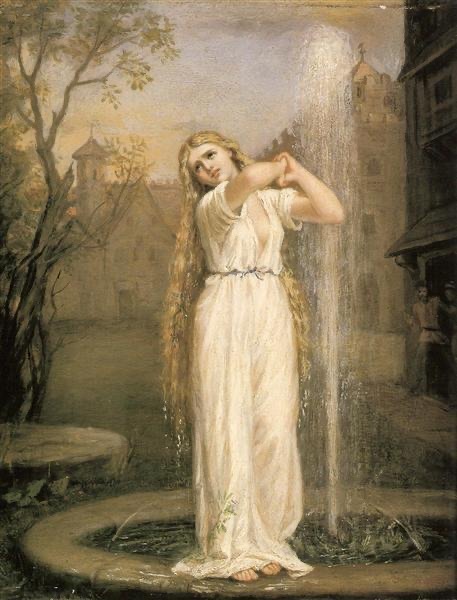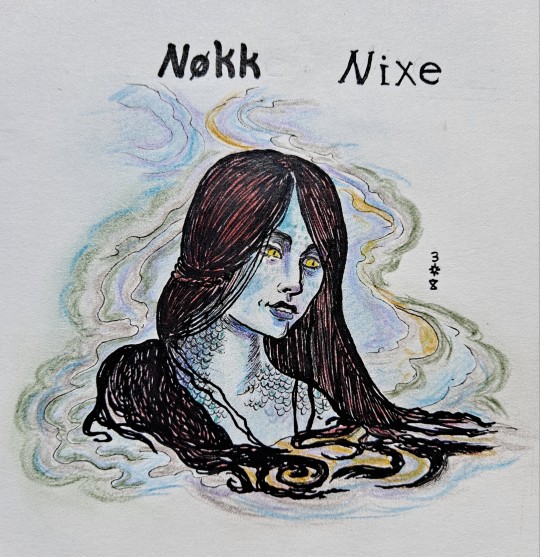#german mythology
Explore tagged Tumblr posts
Text

Ed Simon, from Devil’s Contract: The History of the Faustian Bargain
Text ID: The numinous realm, the astral plane, the transcendent dimension—the sacred—is a terrifying kingdom,
#ed simon#devil’s contract#devil’s contract: the history of the faustian bargain#faustian bargain#quote#nonfiction#philosophy#sociology#nonfiction literature#lit#faust#miscellanea#german mythology
78 notes
·
View notes
Text



Illustrations for The Ring of the Niebelung by Arthur Rackham
107 notes
·
View notes
Text

Undine, John William Waterhouse. 1872.
#aesthetic#art#art history#historical fashion#fashion#historical art#women in art#women#victorian#victorian aesthetic#mythology#German mythology#mythology aesthetic#mythology painting#medieval#medieval style#medieval aesthetic#undine#folklore#folklore aesthetic#water#water aesthetic
132 notes
·
View notes
Text

Siegfried slays the dragon Fafnir, whilst Fafnir's brother, Regin, watches from a safe distance.
#Siegfried#Sigurd#Fafnir#Regin#dragon#dwarf#Völsunga Saga#Nibelungenlied#The Ring of the Nibelung#German folklore#German mythology#Norse mythology#Norse folklore#Donn P. Crane
27 notes
·
View notes
Text

Donnar.
37 notes
·
View notes
Text
Thinking about a german Raven Cycle "looking for a lost sleeping king"
Barbarossa.
8 notes
·
View notes
Text

Finished reading the classic Old English / Germanic epic poem ‘Beowulf’ recently. It was interesting to see just how much influence this work had on fantasy in the modern era. The name Eomer that Tolkien used in ‘The Lord of the Rings’ is taken directly from a minor character in this poem, as is the description of the hall of Heorot, which was undeniably an inspiration for Meduseld, the Golden Hall of Rohan.
On a similar note, High Hrothgar, the monastery of the Greybeards in ‘The Elder Scrolls V: Skyrim’, is named directly after Hrothgar, the King of the Danes in this poem.
Still haven’t seen the Robert Zemeckis animated movie from 2007.
6 notes
·
View notes
Text

WIP; Otto and his twin sister Brunhild in Pomeranian folk dress w/ golden apples. Block colours done.
#ottoway#ww1 fiction#german#original comic#pomeranian#folk dress#deutchland#german mythology#freja and frej#my art#wip#otto odinkirk#brunhild odinkirk#twins#twin brother and sister
9 notes
·
View notes
Text

Nixe are river sirens from germanic folklore- aside from their alleged shape-shifting and ability to murder horny men with incredible effectiveness, their most distinguishing trait is their perpetual moisturized look.
57 notes
·
View notes
Text
The Wolpertinger

A creature from German Folklore, this is a very illusive creature that is said to hide within the Forests of Bavaria...
#germany#wolpertinger#german folklore#folklore#mythical creatures#bavaria#bavarian forest#germanic folklore#mythical bunnies#lunawolfewolf#luna wolfewolf#monster hunter#german mythology#Wolperdinger#critters#forest#forest creature
54 notes
·
View notes
Text


Arthur Rackham
50 notes
·
View notes
Text
Walpurgisnacht

Walpurgisnacht is a celebration assimilated from Celto-Germanic and Christian beliefs. Although named after the English born saint Walburga, the celebration is known in many pagan versions of the same idea: spring.
One of the most popular versions is that Odin would hunt dark winter spirits in the night of April 30th and May 1st. In more Christian beliefs, the night was filled with magic and witches, which must be scared away with large bonfires.
Although sometimes associated with satanism, partially because of Goethe’s “Faust”, the general idea is to come together and light any kind of fire and welcome spring, glad that winter is over.
“Die Walpurgisnacht. Ein gedicht in drei Gesangen” Johann Friedrich Löwen 1756
#spring#walburga#walpurgisnacht#paganism#heithen#Odin#wodan#german mythology#germanic mythology#Germanic#vikings#viking mythology#norse mythology#goethe#Faust#satanism#witches#sabbaths#viking archaeology#merovingian#Merovingian archaeology#frankish#anglo saxon#mythology#St walburga#witch#sabbathaic#esoteric#coven#witches coven
87 notes
·
View notes
Text
The Brother's Grimm Where THE GOATs!

Okay, folks, I just need to share this bit of hyperfixation right now.
As you know, I love mythological research and narratology. I grew up in Germany, so not only did I grow up knowing the Fairytales that those two men have written down, but I also grew up with a ton of schools in my surroundings being named "Brother's Grimm School". Because yeah, they are pretty darn big in Germany.
But until two weeks ago I did not realize how darn important those two were for German literature, mythological research and narratology.
Sure, I was well aware that the two of them did not invent the fairytales, but just collected oral tradition and formalized it, writing it down. And if course - as someone who knows about the importance of oral tradition and how much got lost because it was not written down - I also understood how important this was. Because a lot of those stories would have well gotten lost if it had not been for those two.
Something I did not realize however was, how much of the research methods within German literature research, mythological research and narratology has come from those two. Like, those two nerds did basically singlehandedly lay the groundwork for three different areas of research!
I only realized this now, as I stumbled across one of the "papers" (it was not quite as formalized back then) those two had written. And I was like: "Wait. Those two did actually a lot of research?" And so I started to look into it. And yes, darn.
Also, they did not only collected German oral tradition, but also Slavic oral tradition, and attempted to find people who knew Norse oral tradition still, because they realized that the Edda as written down were not reliable source, because it got colored so heavily by the Christian monks writing it down.
Like, holy shit. I really never realized how important they were for those areas of research. And all we remember them for is fairytales?!
#brothers grimm#fairytales#narratology#german literature#german studies#mythology and folklore#german mythology#norse mythology#slavic mythology
3 notes
·
View notes
Text

Sigurd goes to the dwarf Mime. By Wilhelm Hauschild.
#Wilhelm Hauschild#german mythology#sigurd#mime#dwarves#Sigurðr#Siegfried#Nibelungenlied#Saga Völsunga#richard wagner#Götterdämmerung#twilight of the gods#gram#Der Ring des Nibelungen#notung#nothung#Völundr#gramr#balmung
25 notes
·
View notes
Text

The Lorelei, circa 1836
By Alfred Rethel
Illustration for Reumont's Rhineland legends
#art#painting#fine art#classical art#german art#german artist#19th century art#1800s#illustration#mythology#german mythology#monochrome#beauty#european mythology#european art#lorelei#old art#german painter#german culture#graphic art
14 notes
·
View notes
Text
I'm on a hp roll and my brain rolled out another idea filled with suffering, anger and exhaustion. And crazy German hags that are terrifying but also having a good time.
The others - as in the captured - ain't having a good time.
The summer after an exhausting and exciting end of first year was supposed to be the time of rest and happiness.
Relax, do some casual reading and enjoy another culture.
Or fly around and join the many parties of high society (read: spending time with friends).
Maybe reconvene and read. Repeat and prepare for the workload of the 6th year.
All in all two months without school. A normal time of rest and---
They all were supposed to be anywhere but here (a bedroom, a ballroom, a hotel room), not stuck in the middle of nowhere with only tall trees around.
Each on their own, alone.
Only cackles, whispers around. A cool breeze, the roots like veins pulsting.
The only thing on their mind: get back home
Basically, each one got by accident (or not though they were not specifically targeted) teleported by a nasty trick portkey into the middle of Schwarzwald where a bunch of hags decided to pool more blood for their annual ritual. However, instead of the usual bout of the locals or tourists, some keen dark mage decided to broaden their horizons and get new blood from other countries.
Keep in mind, ya little ones, blood is blood, all that's important is if it's potent.
The hags care only for potency, not where the blood came from, pure or dirty, what stupidity, whether it's old blood or fresh blood.
Poor Draco and his big mouth of great heritage that gets him into a cage instead of his desired freedom. A hard learned lesson, dark mages care for their own obsessions, not always for the same as yours, boy.
May he loose an arm or maybe a leg, who knows, likely the hag.
Well, all three end up in the same place.
With Hermione's bout of courage to whack them with a pan, Percy's protectiveness to get them out as quick as apparating but with legs and Draco's cunning lying to distract the hags, they manage to get out.
Only to end up near the confines of one bastard Gellert Grindelwald.
Anyway, dark rituals ain't only Tom Riddle's special little interest, the world's huge and rich in many cultures.
The many wards, the twisted forests do wonders on freshly acquired trauma in an absolutely negative way.
So what happend is, these three ended up caught in a trafficking ring of a few really nasty dark mages who've been on the watch list of many Wizardry Ministries across Europe at least.
Anyway - by luck, they escape to Egypt (and not really rescued by Bill, poor guy just got a layer of trauma seeing his lil brother falling into cursed quicksand that turns out to be a portal) and get separated. They bounce back and forth between countries.
Meanwhile, the Malfoy's are staging one international intervention after another to get these bastards which makes for a hilarious turnaround as the infamous Lucius Malfoy starts frothing and is after the heads of a few rather nasty dark wizards.
Even more so with the added effort of the Weasley's.
On the non magical side the Granger's went straight to the police and put out a missed poster for their daughter, anxiously ripping into each of their own network to get a clue. At some point they get an update from the wizard police who also check on the non magical side's police (visited country as of yet undecided).
After many anxious weeks the three (and other kidnapped) get back on English soil. Maybe not whole (thanks to a few sacrificing rituals Draco's without a leg), very much traumatized but back.
Their next year is marked with an absence for the first semester because of their stay in St. Mungo's and a quiet comeback for the second one, just in time to smell out the blood of one nasty fucker.
Hermione's head is ready to burst with keeping up with her parents who are confused and scared of the magic world and for her safety but not getting an education is also not an option and other schools require moving which honestly ain't cheap. So she sits tight with headaches in St Mungo's with a somewhat working floo connection so her parents can drop by. Then the school starts, the connection is still working for floo calls just not as frequently as in St Mungo's. But she sits tight, reads as if waiting for who know what. Till Harry and Ron start asking questions and yeah any distraction's welcome (denial is the first stage)
Also because Draco had some really useful blood for rituals, he's now very much keen on burning all dark magic stuff to the ground. (Acceptance comes easy in the shape of utter hatred - this shit cost his leg, his Father ain't gonna stop hearing about it for a while, Narcissa is just glad he's alive and breathing (hopefully not ending up like her sister))
Percy sees the traumatised younglings and starts a crusade of being the most overbearing in charge sergeant on them cause sometimes you latch onto a personality to survive shit and then get attached to these little shits and his head would like to take a break.
It's a mess of tired kids being kids and exhausted adults adulting.
At some point the exhaustion clings to the bones of everyone and everything.
Oh and the basilisk actually gets out into the sunlight.
#hermione granger#percy weasley#draco malfoy#hp fanfic#unusual triad#not really golden trio#hermione granger percy weasley draco malfoy#german mythology#german folklore#gellert grindelwald#harry potter fanfic#hp fandom
2 notes
·
View notes